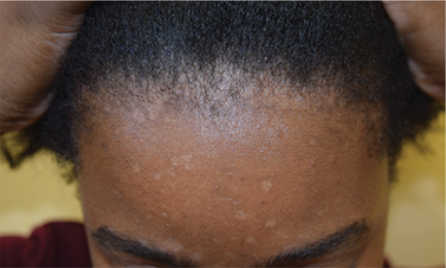January 2019, the Journal of Drugs in Dermatology (JDD) published the article, “Seborrheic Dermatitis in Skin of Color: Clinical Considerations.” This article was written by May Elgash BS, Ncoza Dlova MBChB, FCDerm PhD, Temitayo Ogunleye MD, Susan C. Taylor MD.
Seborrheic dermatitis (SD) is a skin disorder affecting 3% to 12% of the population. Seborrheic dermatitis may be more prevalent among skin of color e.g. African Americans (6.5%) and West Africans (2.9-6%).
A recent study of various ethnic groups in a hospital-based dermatology practice, compared the prevalent diagnoses for patients. Seborrheic dermatitis ranked within the top five diagnoses in black patients.
ABSTRACT
Seborrheic dermatitis is a common, relapsing, inflammatory skin condition of unclear etiology. The Malassezia yeast genus are believed to play a role. Allergic reaction can also play a role. Seborrheic dermatitis commonly affects the face and the scalp. Seborrheic dermatitis areas of the skin with high sebum production are most effected like the face and scalp, including nasolabial folds, glabella, eyebrows, beard, ears, retroauricular skin, sternum, and other skin folds. Seborrheic dermatitis may present differently in individuals with skin of color. Darker-skinned individuals may present with scaly, hypopigmented macules and patches in typical areas of involvement. Arcuate or petal-like patches may be seen, specifically termed petaloid seborrheic dermatitis. Children of color often do not experience the classic “cradle cap” appearance of seborrheic dermatitis, and have erythema, flaking, and hypopigmentation of the affected areas and folds of skin. Seborrheic dermatitis tends to respond well to conventional treatments, although it tends to recur. Treatment of sebborrheic dermatitis include topical corticosteriods, pimecrolimus cream, salicylic acid, selenium sulfide, etc. Skin of color patients may require a modified treatment approach which takes into account differences in hair texture and hair washing frequency. This paper aims to highlight these differences to help reduce disparities in the management of seborrheic dermatitis in patients of color. J Drugs Dermatol. 2019;18(1):24-27.
Visit JDDonline.com to read the full article.
Attend Skin of Color Update to learn more about clinical dermatology considerations in patients with skin of color.

